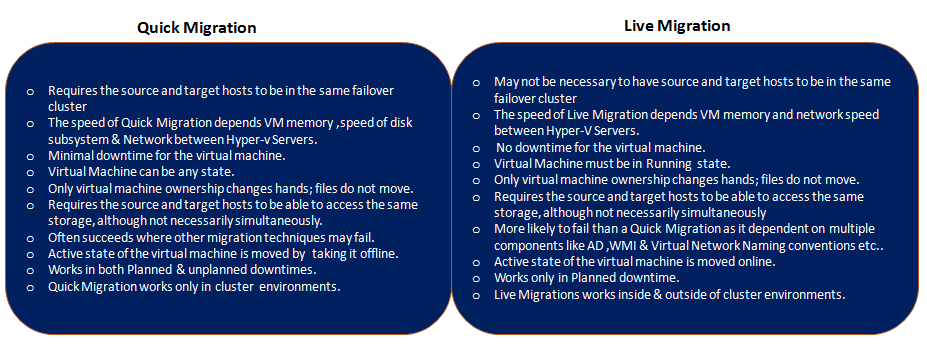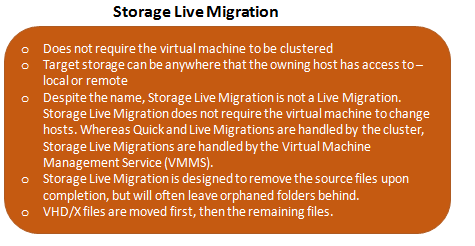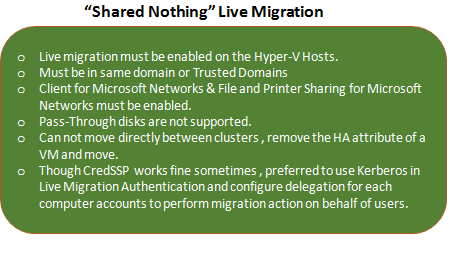It is very important for an architect to select the right Hyper-V high-availability or migration technology to deploy in the production environment as MS introduced multiple choices. In addition to the Hyper-V high-availability & migration technologies that were introduced in Windows Server 2008 RTM and R2, the new Hyper-V Version 3.0 running on Windows Server 2012 Operating System comes with a bunch of new migration technologies.
Although Windows Server 2012 R2 does not introduce any new migration technologies, there have been many improvements over the existing Hyper-V versions. These technologies not only provide the high-availability of virtual machines running on a Hyper-V environment but also help reduce the IT cost. Example Shared Nothing Live migration & Hyper-v Replica which will be discussed in below section
There are five different VM migration technologies and one replication technology available depending on the operating system version i.e., Quick Migration, Live Migration, Quick Storage Migration, Storage Live Migration, Shared-Nothing Live Migration & Hyper-v Replica
Quick Migration:
Hyper-V Quick Migration is high-availability feature introduced with first version of Windows Server 2008 RTM. With Quick migration, VM will be moved from running state to saved state (hibernated) on a shared storage location and then transfer VM ownership to destination host to resume the virtual machine to running state. This VM migration perceives minimal downtime.
Download below pdf for deep dive of Quick Migration
Live Migration
Hyper-V Live Migration is first introduced in Windows Server 2008 R2 and enhanced lot in later versions. It allows you to transparently move running Virtual Machines from one Hyper-V host to another without perceived downtime. The guest operating system of the migrating virtual machine is not aware that the migration is happening, so no special configuration for the guest is needed.
Often there is confusion between Live Migration and high availability (HA). This is because they went hand in hand and dependent on cluster and shared storage until Windows 2012. The tie between Live Migration and Failover Clustering has been broken from Windows 2012.
Live Migration is a planned and preventative action – virtual machines move with no downtime to service availability. From 2012, you can live migrate a VM between two non-clustered hosts, between clusters, and of course, between clustered hosts.
High availability, on the other hand, is reactive and unplanned. HA is the function of failover clustering. Hosts are clustered and virtual machines are marked as being highly available
Download below pdf for deep dive of Live Migration
Quick differences between Quick & Live Migration
Storage Live migration:
Starting with the 2012 version, Hyper-V now has a mechanism to relocate the storage for a virtual machine, even while it is turned on. This works within a single Hyper-V Host or across Hyper-V Hosts in a cluster without any downtime. A Storage Live Migration might or might not occur in conjunction with a Live Migration. Below are some of characteristics.
Download below pdf for deep dive of Storage Live Migration
Storage Live Migration -Deep Dive
Shared-Nothing Live Migration (SNLM):
Live migration without shared storage (also known as “Shared Nothing” live migration) is new in Windows Server 2012 and this method does not require the use of ‘Windows Failover Cluster’ and ‘Shared Storage infrastructure’.
A Shared Nothing Live Migration is similar to a standard Live Migration in that it transfers a virtual machine from one host to another without interruption, but the primary difference is that the virtual machine non-clustered. However, it is possible to transfer from a node that is a cluster member, if the virtual machine is not a cluster role at the time of transfer.
‘Shared-Nothing Live Migration’ is a mobility solution, which you can use to migrate virtual machine from one host to another which includes VM configuration & VHD files to a new location you specify during the move wizard.
‘Shared-Nothing Live Migration’ is a technology name and a feature provided on Windows Server 2012. You do not see ‘Shared-Nothing Live Migration’ name anywhere on the Hyper-V Manager UI. Instead, what you see is that “Move” button when you right-click on a virtual machine running on a Hyper-V Host. Below are some of characteristics.
Download below pdf for deep dive of Shared Nothing Live Migration
Shared-Nothing Live Migration-Deep Dive
Hyper-V Replica
It is a disaster technology first introduced in Windows Server 2012, which uses a different set of underlying components to replicate virtual machine data to another site configured as a disaster recovery site. ‘Hyper-V Replica’ does not require ‘Windows Failover Cluster’ to be configured on Hyper-V Hosts. ‘Hyper-V Replica’ works differently from all other Hyper-V migration technologies.
A Hyper-V Replica installation consists of a primary site where all Hyper-V hosts and the respective Virtual Machines are running. Besides the primary site there’s also a replica site. Hyper-V hosts are also located in this replica site but they contain replicas of virtual machines that are running in the primary site. Every five minutes, the primary site sends information regarding these last five minutes to the replica site where this information is replayed into the Hyper-V Replica. When disaster strikes in the primary site, the virtual machines are still available in the replica site. Part of the disaster recovery process is taken up with firing up these virtual machines. Since the replication is an asynchronous mechanism, you will always face some data loss, though it should be very minimal.
Click here for deep dive of Hyper-V Replication
Below table summarizes all VM migration technologies
| Migration Technology | Available in Operating System | Downtime | Tech Type | Transfer Type | Migration Type | AD Domain |
| Quick Migration | Windows 2008/R2/2012/R2 | Yes | HA/Cluster | Automatic/Manual Migration | Virtual Machine | Required |
| Live Migration | Windows 2008 R2/2012/R2 | No | HA/Cluster | Automatic/Manual Migration | Virtual Machine | Required |
| Quick Storage Migration | Windows 2008/R2/2012/R2 | Yes | Mobility | Manually using SCVMM | Virtual Machine Storage | Not Required |
| Live Storage Migration | Windows 2012/R2 | No | Mobility | Manually using Hyper-V Manager | Virtual Machine Storage | Not Required |
| Shared-Nothing Live Migration | Windows 2012/R2 | No | HA/Cluster | Manually using Hyper-V Manager | Virtual Machine | Required |
| Hyper-V Replica | Windows 2012/R2 | Yes | Replication | Manually using Hyper-V Manager | Virtual Machine | Not Required |


